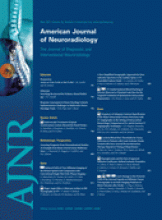Research ArticleBrain
Apparent Diffusion Coefficient Histogram Analysis Stratifies Progression-Free Survival in Newly Diagnosed Bevacizumab-Treated Glioblastoma
W.B. Pope, A. Lai, R. Mehta, H.J. Kim, J. Qiao, J.R. Young, X. Xue, J. Goldin, M.S. Brown, P.L. Nghiemphu, A. Tran and T.F. Cloughesy
American Journal of Neuroradiology May 2011, 32 (5) 882-889; DOI: https://doi.org/10.3174/ajnr.A2385
W.B. Pope
A. Lai
R. Mehta
H.J. Kim
J. Qiao
J.R. Young
X. Xue
J. Goldin
M.S. Brown
P.L. Nghiemphu
A. Tran

References
- 1.↵
- Norden AD,
- Drappatz J,
- Wen PY
- 2.↵
- Rahman R,
- Smith S,
- Rahman C,
- et al
- 3.↵
- Fischer I,
- Gagner JP,
- Law M,
- et al
- 4.↵
- Friedman HS,
- Prados MD,
- Wen PY,
- et al
- 5.↵
- Kreisl TN,
- Kim L,
- Moore K,
- et al
- 6.↵
- Lai A,
- Nghiemphu PL,
- Green RM,
- et al
- 7.↵
- Pope WB,
- Lai A,
- Nghiemphu P,
- et al
- 8.↵
- Wen PY,
- Macdonald DR,
- Reardon DA,
- et al
- 9.↵
- Clarke JL,
- Chang S
- 10.↵
- 11.↵
- Chamberlain MC
- 12.↵
- Claes A,
- Wesseling P,
- Jeuken J,
- et al
- 13.↵
- Fukushima T,
- Takeshima H,
- Kataoka H
- 14.↵
- Jung TY,
- Jung S,
- Moon KS,
- et al
- 15.↵
- Zhang J,
- Stevens MF,
- Laughton CA,
- et al
- 16.↵
- 17.↵
- Ellingson BM,
- Malkin MG,
- Rand SD,
- et al
- 18.↵
- Carlson MR,
- Pope WB,
- Horvath S,
- et al
- 19.↵
- Pope WB,
- Kim HJ,
- Huo J,
- et al
- 20.↵
- Higano S,
- Yun X,
- Kumabe T,
- et al
- 21.↵
- 22.↵
- Otsu N
- 23.↵
- Hegi ME,
- Diserens AC,
- Gorlia T,
- et al
- 24.↵
- Macdonald DR,
- Cascino TL,
- Schold SC Jr.,
- et al
- 25.↵
- Brandes AA,
- Franceschi E,
- Tosoni A,
- et al
- 26.↵
- Wong ET,
- Brem S
- 27.↵
- Zhou Q,
- Guo P,
- Kruh GD,
- et al
- 28.↵
- 29.↵
- Minamikawa S,
- Kono K,
- Nakayama K,
- et al
In this issue
Advertisement
W.B. Pope, A. Lai, R. Mehta, H.J. Kim, J. Qiao, J.R. Young, X. Xue, J. Goldin, M.S. Brown, P.L. Nghiemphu, A. Tran, T.F. Cloughesy
Apparent Diffusion Coefficient Histogram Analysis Stratifies Progression-Free Survival in Newly Diagnosed Bevacizumab-Treated Glioblastoma
American Journal of Neuroradiology May 2011, 32 (5) 882-889; DOI: 10.3174/ajnr.A2385
0 Responses
Apparent Diffusion Coefficient Histogram Analysis Stratifies Progression-Free Survival in Newly Diagnosed Bevacizumab-Treated Glioblastoma
W.B. Pope, A. Lai, R. Mehta, H.J. Kim, J. Qiao, J.R. Young, X. Xue, J. Goldin, M.S. Brown, P.L. Nghiemphu, A. Tran, T.F. Cloughesy
American Journal of Neuroradiology May 2011, 32 (5) 882-889; DOI: 10.3174/ajnr.A2385
Jump to section
Related Articles
- No related articles found.
Cited By...
- Advanced Distance-Resolved Evaluation of the Perienhancing Tumor Areas with FLAIR Hyperintensity Indicates Different ADC Profiles by MGMT Promoter Methylation Status in Glioblastoma
- Pretreatment ADC Histogram Analysis as a Prognostic Imaging Biomarker for Patients with Recurrent Glioblastoma Treated with Bevacizumab: A Systematic Review and Meta-analysis
- Diffusion Characteristics of Pediatric Diffuse Midline Gliomas with Histone H3-K27M Mutation Using Apparent Diffusion Coefficient Histogram Analysis
- Prognostic Implications of Gadolinium Enhancement of Skull Base Chordomas
- Correlation of 18F-FDG PET and MRI Apparent Diffusion Coefficient Histogram Metrics with Survival in Diffuse Intrinsic Pontine Glioma: A Report from the Pediatric Brain Tumor Consortium
- ACRIN 6684: Assessment of Tumor Hypoxia in Newly Diagnosed Glioblastoma Using 18F-FMISO PET and MRI
- Differentiating Tumor Progression from Pseudoprogression in Patients with Glioblastomas Using Diffusion Tensor Imaging and Dynamic Susceptibility Contrast MRI
- The Added Prognostic Value of Preoperative Dynamic Contrast-Enhanced MRI Histogram Analysis in Patients with Glioblastoma: Analysis of Overall and Progression-Free Survival
- Lessons From Anti-Vascular Endothelial Growth Factor and Anti-Vascular Endothelial Growth Factor Receptor Trials in Patients With Glioblastoma
- Phase II Study of Bevacizumab, Temozolomide, and Hypofractionated Stereotactic Radiotherapy for Newly Diagnosed Glioblastoma
- Diffusion-Weighted Imaging in Cancer: Physical Foundations and Applications of Restriction Spectrum Imaging
- A Prognostic Model Based on Preoperative MRI Predicts Overall Survival in Patients with Diffuse Gliomas
- Pretreatment ADC Histogram Analysis Is a Predictive Imaging Biomarker for Bevacizumab Treatment but Not Chemotherapy in Recurrent Glioblastoma
- Diffusion-Weighted MR Imaging and MGMT Methylation Status in Glioblastoma: A Reappraisal of the Role of Preoperative Quantitative ADC Measurements
- Do Imaging Biomarkers Relate to Outcome in Patients Treated with VEGF Inhibitors?
This article has not yet been cited by articles in journals that are participating in Crossref Cited-by Linking.
More in this TOC Section
Similar Articles
Advertisement











